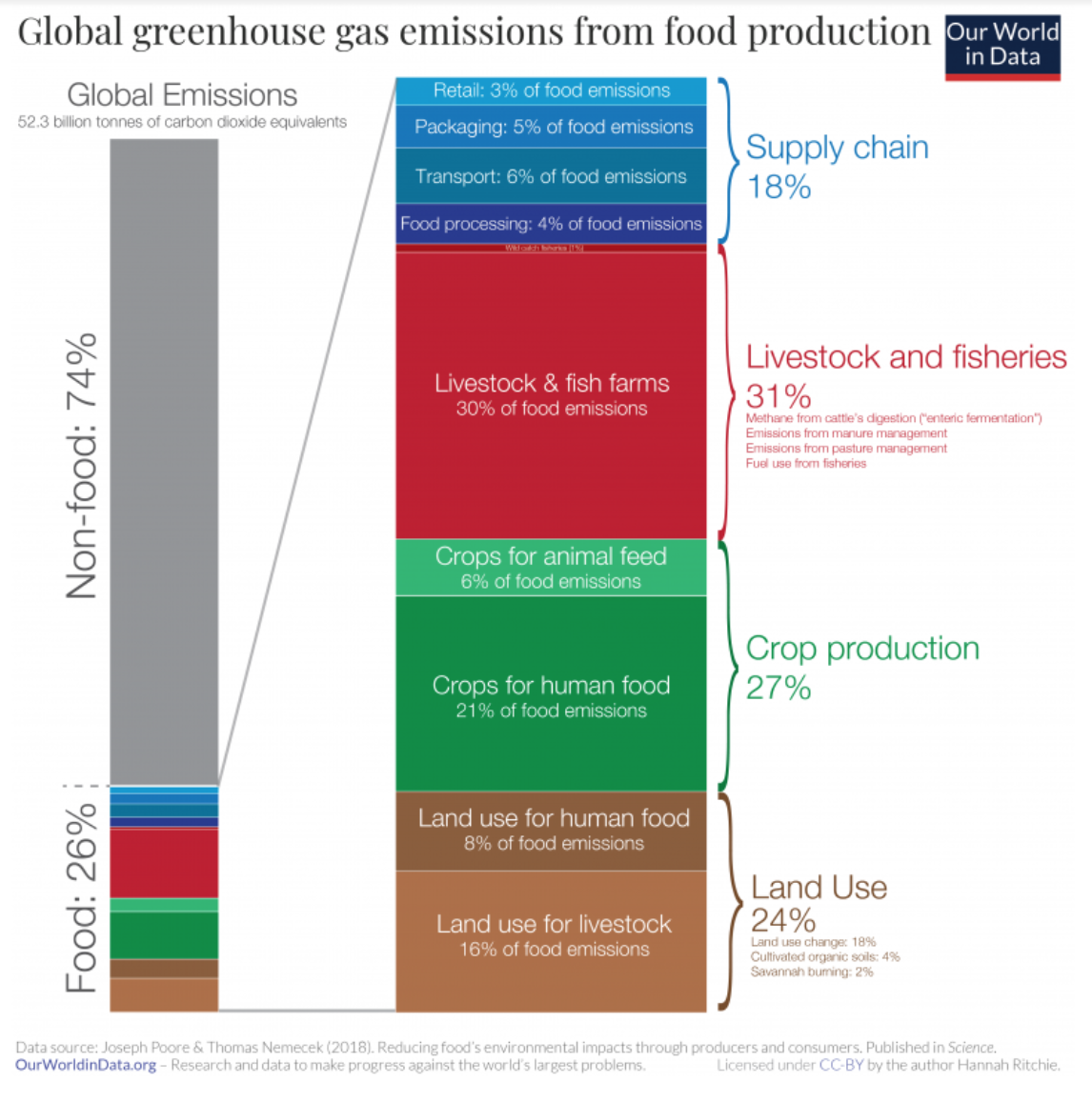What's for lunch? How our food choices actually impact the environment
Authors: Kevin Nguyen (Events Co-director) & Ben Griffiths (Vice President of Operations)
The impact of animal agriculture on the environment is an often needlessly controversial topic that is becoming increasingly relevant as the demand for animal products is projected to increase dramatically. Being consistently exposed to often misleading and contradictory information makes it exceedingly difficult to develop an accurate perspective on what these impacts are.
This piece will present a clear and evidence-based summary of the core impacts of animal agriculture with regards to land use, water use, and pollution alongside some key considerations in light of those impacts.
Agriculture and land use
Our land is a scarce resource being depleted by human action, so it’s incredibly important to be aware of what the key drivers of land use are so that we can preserve global biodiversity, beautiful landscapes, and meet human needs with as little destruction as possible.
Animal agriculture is one of these key drivers as it has a disproportionate effect on land use relative to plant-based foods and is a major contributor to deforestation.
This graph represents how wildly inefficient animal agriculture is with respect to land use. Despite livestock grazing and feed making up 77% of agricultural land, it only accounts for 18% of the total global calorie supply and 37% of the global protein supply. This is in stark contrast to plant-based foods which are a much more efficient source of nutrition.
What makes these numbers even more startling is the fact that this is largely driven by our lifestyles in high income countries. If, alternatively, every country were to adopt the average diet and meat consumption of the UK and USA it would require using 95% and 178% of total global habitable land for agriculture respectively; it would simply be impossible.
This is the inherent result of plants occupying a lower trophic level whereas livestock occupy a higher trophic level, meaning they consume plants in the lower trophic level before being eaten themselves by humans. The problem with this is that energy is lost with each successive trophic level, and that creating and sustaining life in higher trophic levels is more energy intensive, thus making it a more inefficient calorie source. Naturally, this is an intuitive result given that plant foods can be eaten directly as soon as crops yield, whereas animal products require feeding plant matter to an animal for multiple years before slaughter or while producing eggs and dairy. Cutting out “the middle man” in this context, and instead producing a nutritionally diverse range of plant-foods would therefore be a more sustainable way of feeding the population.
The great Amazon rainforest has been subject to devastation through the well-covered fires of 2019 and ongoing deforestation. However, what isn’t as well known is the central role of animal agriculture in causing and amplifying these problems.
Cattle ranching alone is responsible for 80% of commercial deforestation in the Amazon, which is particularly pertinent for global consumers of meat given Brazil is the world’s largest exporter of bovine and poultry meat. Additionally, cattle-linked deforestation also extends to illegal deforestation, as brought to light by this investigation into the topic.
So how does this farming have anything to do with the fires? In the Amazon, the case is that deforestation (particularly the burning of felled trees) is the leading cause of fires, both controlled and wild. Given that cattle ranching is the leading cause of this deforestation, the connection animal agriculture has to devastating fires cannot be ignored.
Water use we can’t see: agricultural water demand
For many of us, from a young age our parents have emphasised to us the importance of saving water. If you were to go ahead and google “how to conserve water”, you would find the following results, which are largely reminiscent of the presentations we’d have seen in primary and secondary school.
The emphasis here is placed on using more efficient shower heads, turning off taps when you’re not using them and ensuring you always have a full load when using the washing machine. Although these habits are undoubtedly beneficial, their effects are negligible in comparison to the effects of our decisions regarding food.
Agriculture uses more freshwater than any other human activity, and nearly a third of this is required for livestock. The water used to produce our food makes up for 90% of all water used by the average Australian household. However it is important to note that livestock production is largely (87.2%) green-water (rain and precipitation that falls directly on the land), and the amount of blue water from rivers, lakes, and ground water is equal to 7% of the green-water use. Blue water is particularly important as it competes more directly with other uses of water, including the maintenance of aquatic ecosystems.
The following graph visually depicts the amount of freshwater usage to produce one kilogram of a particular product.
To put this into perspective, a 5 minute shower uses about 100 litres of water and the average Australian eats about 250g of meat a day (if this were to be lamb, that would then require over 450 litres of water). Unlike greenhouse gas emissions, which have the same climatic effect regardless of where it is emitted, the impact of water use heavily depends on the water source, location and season in which the water is being used. Likewise, there are significant variations in water footprint depending on the type of meat and production systems. For example, on average, beef farming is more than three times as water intensive as chicken production (per kg of meat).
Admittedly it may be easier to visualise the water footprint of our home appliances, however the water required for the food we put on our dinner plates should always be something we seek to be conscious of.
A less discussed source of greenhouse gases
Greenhouse gas (GHG) emissions are the cause of global warming, which has the potential to reap untold havoc on biodiversity and our civilisation, through increased food insecurity, natural disasters, forced displacement, immense flooding, and the spreading of tropical diseases.
Though nowadays we are quick to note the role transport and energy play in creating emissions, we aren’t so well versed in acknowledging the role animal agriculture plays as a key driver of emissions.
The key GHGs involved in the meat industry are carbon dioxide (CO2), methane (CH4), and nitrous oxide (N2O). These are created through a combination of digestive processes, manure, pasture management and land use.
The graph to the right illustrates the relative contributions of different elements of food production towards global GHG emissions.
Here, it’s clear to see that livestock is the single biggest contributor of methane emissions. Livestock production alone (not including other sources of animal agriculture) contributes 15% of total anthropogenic CO2 emissions.
At current rates of consumption, the combined GHG emissions of the meat industry alone would sum to 0.55 degrees of global warming over 100 years.
Sound small? The implications of this are in fact rather horrifying when we consider that the earth has already warmed by 1 degree above pre-industrial levels, while the IPCC, a key climate authority, recommends keeping global warming to less than 1.5 degrees celsius to avert severe consequences that threaten to disrupt human civilisation. So that 0.55 degree projection poses a risk that transcends the agricultural sphere alone, and will have a global impact. Moreover, meat consumption is projected to increase by 76%. This means that the actual global GHG emissions of meat are likely to be even worse than this already bleak projection that assumes no increase in consumption.
Plastic in the big blue: the consequences of overfishing
We’re sure many of you have watched one of David Attenborough’s “Blue Planet” documentaries and marvelled at the fantastic depths and myriad of stunning creatures in our oceans. There’s something deeply saddening about juxtaposing that beauty with the reality of what we’re doing to these environments, but it’s fundamentally important that we face this reality together in order to tackle the root causes of this destruction.
The environmental impacts of commercial fishing affect the health of our oceans, fisheries, economies and communities around the world.
Increasing demand, improved technology and poor fishing practices have meant that some fish populations are the target of heavy fishing pressure, and subsequently become depleted or collapse completely. The fish vulnerable to this are fuelled by our lifestyle demands for popular species such as cod and tuna, as well as other species that are slow to mature such as sharks.
Generally when we think of plastic pollution, we immediately think of single-use plastics such as plastic containers, water bottles and bags. Although all of these efforts are worthwhile to consider in our daily lives, they aren’t exactly the biggest culprits in the broader picture. The fishing industry is one of the largest drivers of plastic pollution.
The Great Pacific Garbage Patch (GPGP) is the largest of five offshore plastic accumulation zones, located halfway between Hawaii and California. It is approximately 1.6 million square kilometres (which is over 7 times the size of Victoria). It contains an estimated 1.8 trillion pieces of plastic weighing at nearly 80,000 metric tonnes. What’s in there? Most of this plastic is abandoned fishing gear: 46% fishing nets, with the rest largely comprising other industry gear such as ropes, eel traps, crates and baskets.
Additionally, this industry is environmentally harmful even to non-targeted species. Marine life is often caught unintentionally during commercial fishing and then discarded back into the water, often dead or injured. Moreover, certain parts of fishing gear may be more destructive when lost or discarded, leading to what is known as “ghost fishing”; the gear continues killing marine life indiscriminately for decades, entangling and suffocating fish, sharks, whales, dolphins, sea turtles, seals and birds. An estimated 30% percent of the decline in some fish populations are a result of discarded fishing equipment, while more than 70% of reported marine animal entanglement involve abandoned plastic fishing nets.
Ultimately, marine habitats and natural fish reproduction cannot keep up with demand, and as a result 24% of fish species are overexploited, depleted, or recovering from depletion. More broadly, this is a large contributor to the decline of 49% in the size of marine populations globally.
Suggestions
We’ve given you a lot of information to take in and consider, and it may have been a little overwhelming at times.
The main thing we would like you to take from this article is that we have a choice to make in simply being aware of our diet’s environmental impact, and we should consider this when making everyday food choices.
Rather than being intimidated by perfectionism or a desire to completely overturn your normal eating habits, it’s important to be guided by a philosophy of making better choices than the ones you made yesterday. Everyone is at a different stage in their journey and it’s important to respect others and yourself, so long as everyone is committed to continuing on that journey each day.
With respect to the environmental impact of diet, the least harmful course of action would be to adopt a plant-based diet or minimise your consumption of animal products, particularly red meat which, as we have seen, has the largest impact across each of our points of analysis.
“A vegan diet is probably the single biggest way to reduce your impact on planet Earth, not just greenhouse gases, but global acidification, eutrophication, land use and water use”
If you’d like to learn more about how you can contribute towards a more sustainable planet, feel free to read some of our previous articles:








